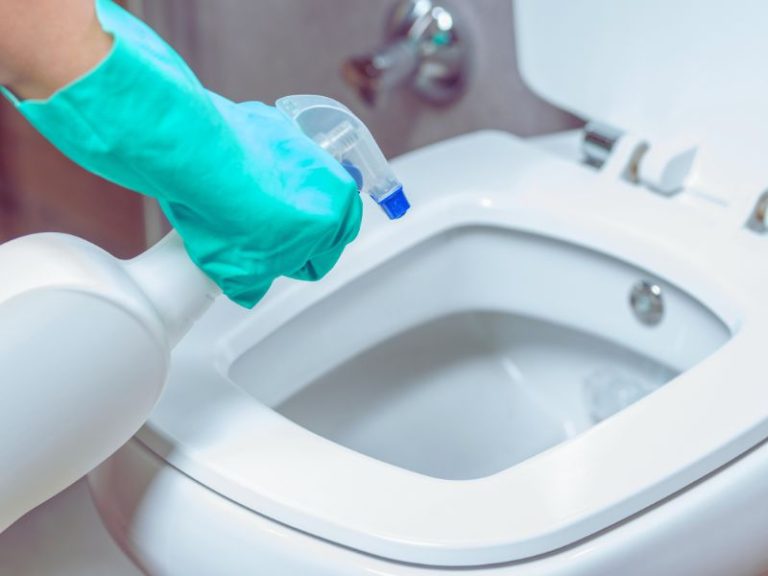Have you ever wondered why your toilet gets those unsightly rings so quickly? Toilet rings are not only unpleasant to look at but can be quite tenacious when it comes to removing them.
Let’s explore the reasons behind these stubborn rings, how to prevent them, and the best methods for removing rings of different colors and textures.
What Causes Toilet Rings?
Toilet rings can be caused by a variety of factors, and identifying the specific cause of the ring is the first step to effectively addressing the problem. Here’s a closer look at the common causes of toilet rings, along with clear examples and descriptions to help homeowners identify them:
Fungus and Mold
Fungus and mold thrive in the damp and dark environment of a toilet. When these microorganisms are responsible for toilet rings, you’ll notice the following characteristics:
- Color: Green or grey rings, often with irregular shapes or patterns.
- Texture: Slimy and slippery to the touch.
- Odor: A musty or moldy smell may be present in the bathroom.
You might notice a greenish-grey ring just above the water line, accompanied by a persistent, mildew-like odor. This would suggest the presence of fungus or mold, such as Serratia marcescens.
Mineral Deposits
Mineral deposits from hard water can accumulate over time, forming a layer of residue on the toilet surface. To identify mineral deposit-related toilet rings, look for these signs:
- Color: Yellow or brown rings, often with a uniform appearance around the water line or below the rim.
- Texture: Gritty, hard, or crusty to the touch.
- Consistency: The ring may be thicker in some areas and thinner in others, depending on the mineral concentration.
You might see a yellowish-brown ring with a gritty texture that’s more pronounced in certain areas of the toilet bowl. This would indicate the presence of mineral deposits, such as those caused by iron.
Rust and Corrosion
Old pipes and fixtures can break down and release tiny particles into the water, leading to rust and corrosion-related toilet rings. To recognize these types of rings, consider the following characteristics:
- Color: Orange or red rings, often appearing as streaks or patches.
- Texture: Rough, with a texture similar to coarse sandpaper.
- Location: The ring may be more noticeable around the rim or the inlet holes where water enters the bowl.
Rust presents itself as reddish-orange streaks or speks running down the sides of the toilet bowl with a rough texture that feels similar to sandpaper. These signs would point to rust and corrosion, possibly from copper pipes or fixtures.
If you’re not sure, see here for a full guide on identifying odd stains and other substances in your toilet.
How to Prevent Toilet Rings?
There are a couple of simple ways to prevent rings before they happen.
Use Soft Water or Water Softener Tablets for Mineral Deposits
Soft water can be a great ally in the fight against toilet rings. It contains fewer minerals, which prevents them from sticking to the toilet surface. You can use water softener tablets or install a water softener system in your home to reduce the hardness of your water. To test your water’s hardness, try using soap – soft water will create more suds.
Keep the Toilet Clean and Dry to Prevent Mold
Regular cleaning is key to preventing toilet rings caused by mold. A clean and dry environment makes it difficult for fungus and mold to grow and removes dirt or stains before they become permanent.
Use natural or chemical cleaners that are safe and effective for various types of toilet rings. After cleaning, dry the toilet bowl with a paper towel or a hairdryer.
How to Remove Toilet Rings?
There are a couple of simple ways to clean and remove toilet rings using common household items.
Use Vinegar and Baking Soda
Vinegar and baking soda are natural, inexpensive ingredients that can dissolve mineral deposits and kill fungus and mold.
But we’ve summarizesd the steps here for this process here.
1. Pour one cup of white vinegar into the toilet bowl and let it sit for 1-2 hours.
2. Sprinkle baking soda onto the vinegar-soaked ring.
3. Scrub the ring with a toilet brush or cloth until it disappears.
4. Flush the toilet to rinse away the vinegar and baking soda.
See here for a full guide.
When using vinegar, protect your skin and eyes from splashes by wearing gloves or goggles.
Use Pumice Stone or Sandpaper
Pumice stone and sandpaper are abrasive tools that can effectively remove stubborn stains and rust from the toilet surface. Follow these steps to use them:
1. Wet the pumice stone or sandpaper with water or soap.
2. Gently rub the ring using circular motions.
3. Rinse the toilet surface frequently to remove debris and check your progress.
4. Stop when the ring is gone and rinse the toilet thoroughly.
To prevent scratching the toilet surface, always use water or soap as lubricant.
Conclusion
As you bid adieu to those stubborn toilet rings, remember that prevention is just as important as removal. By understanding the root causes of these unsightly rings, you can take proactive steps to keep your toilet clean and pristine.
With a combination of regular cleaning, water treatment, and the right tools and techniques, your bathroom can maintain its sparkle and remain free of unsightly rings.

